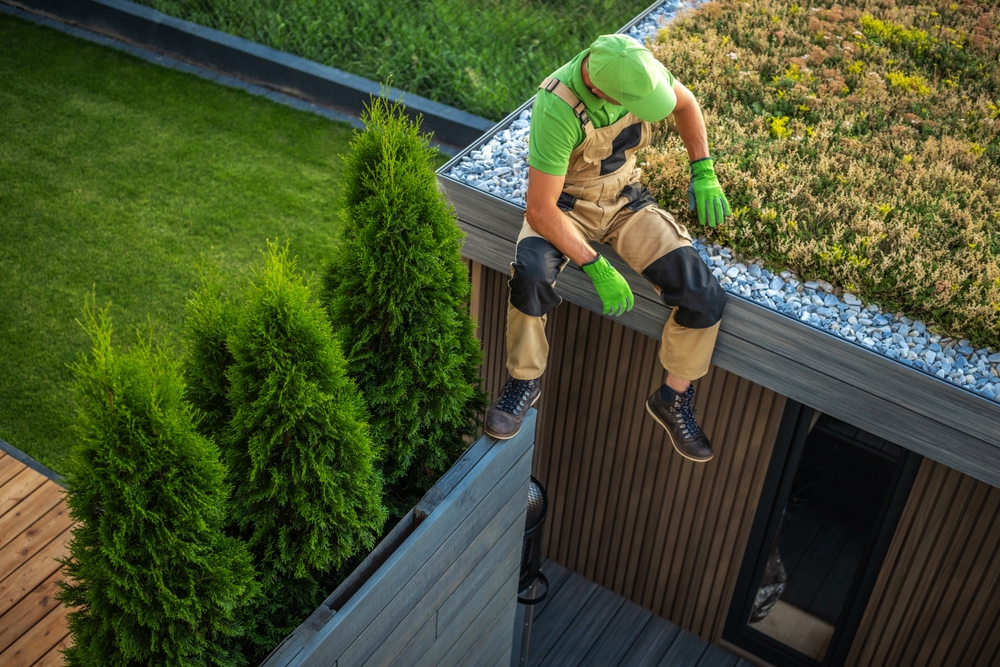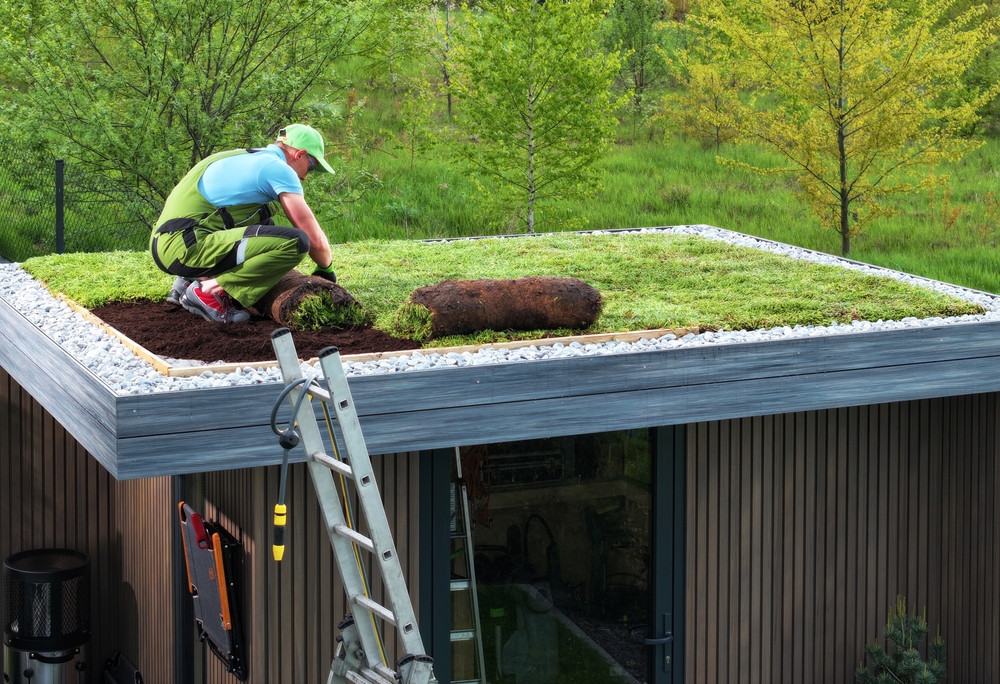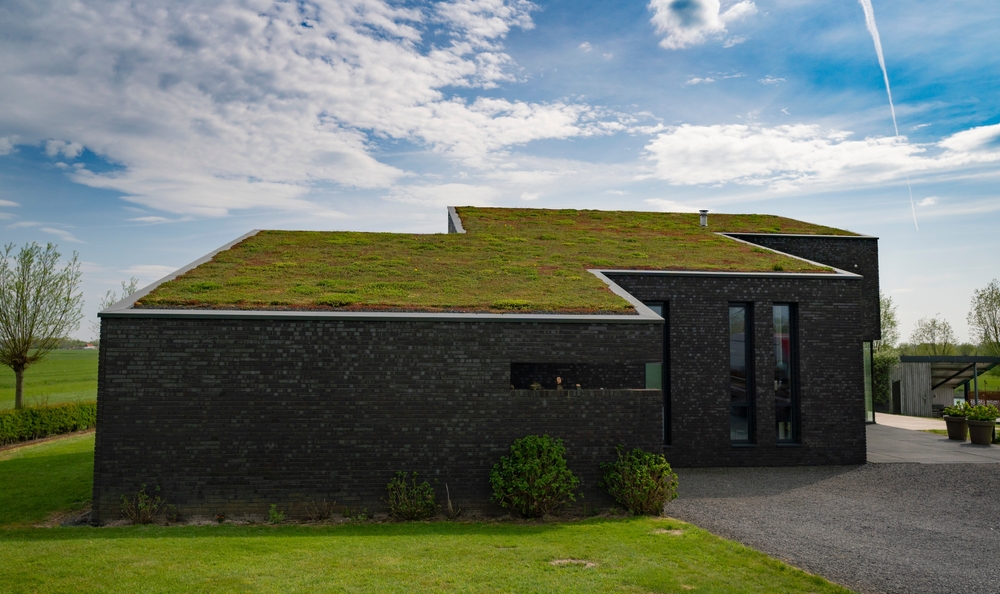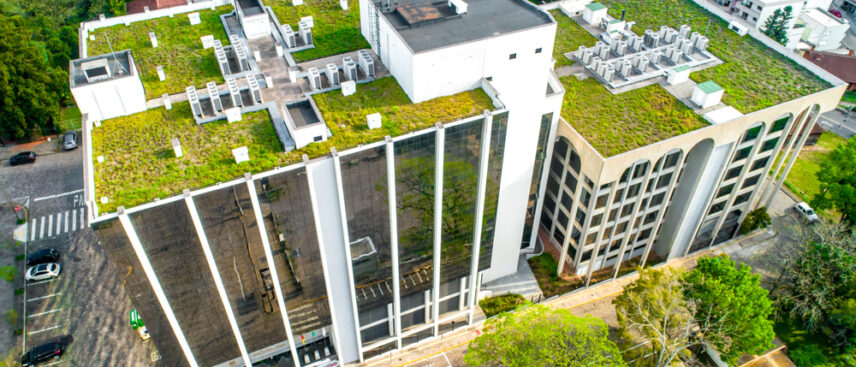The beauty, environmental, financial, and psychological benefits of green roofs make them an increasingly popular, practical, and versatile roofing option for those seeking sustainable architecture. Read on to learn more about how a green roof, also referred to as a rooftop garden or living roof, benefits your home.
Transforming Your Rooftop: What is a Green Roof?
A green roof consists of several layers that provide waterproofing, drainage, and soil to sustain the plants selected for growing on the roof. These layers are installed directly on a traditional roof structure.
Green roofs with a shallow layer of soil support drought-resistant plants with shallow root systems, while those with deeper layers of soil support various uses and plants.
Benefits of Green Roofs
Living roofs can help to cool the area around an urban home, improve air quality, provide a habitat for birds and pollinating insects, reduce utility costs, reduce stress, and offer a retreat and yard-like space amidst the blacktop and concrete of a city environment.

Your Urban Rooftop Lawn
These rooftop gardens can be exactly that, a garden. Depending on the size of your roof, you can divide the space into areas for multiple uses.
- You can grow flowers around a seating area for reading, relaxing, and meditating. Studies by environmental psychologists show that the presence of greenery and natural elements reduces stress levels and promotes mental well-being.
- You can have an area of raised beds or containers for a vegetable and herb garden. You gain fresh herbs, vegetables, and small fruits like strawberries. You could even grow dwarf fruit trees in a large enough container.
- You also gain the opportunity to share learning about the plants best suited to urban rooftop gardening in your area, container gardening, sustainable gardening practices, and the birds, pollinating insects, and other wildlife your urban rooftop oasis attracts.
Because watering container gardens can result in a loss of fertilizer and because rooftop gardens can dry out more quickly than a ground-level garden, you and your family also gain the opportunity to learn about choosing and applying fertilizer, and the self-watering containers and automated irrigation systems that simplify maintenance of your garden. You can also have a grassy play area for your children and your fur babies!
An additional benefit of green roofs, especially when they serve as rooftop gardens, is that they absorb rainwater. That improves stormwater management by reducing the amount of water running into city storm drains. It also reduces the amount of pollutants that rain running off of roofs carries into the water system. Additionally, living roofs don’t just filter pollutants from rainwater and filter pollutants from city air.
However, as with ground-level lawns and gardens, you must deal with weeds, plant diseases and pests, pruning, and mowing. Consider it part of the shared family learning experience. Carefully choosing plants that are suited to your climate reduces some of the watering and maintenance concerns.
A More Comfortable, Energy-Saving, and Cost-Cutting Living Space
A living rooftop makes your home’s interior and exterior more comfortable. Green roofs insulate your home in the summer and winter, reducing heating and cooling costs by up to 30 percent.
In addition to providing insulation for your home, environmental studies show that green roofs counteract the urban heat island effect.
Green roofs absorb heat and release moisture, significantly cooling the ambient air temperature by up to 5 to 9 degrees Fahrenheit (3 to 5 degrees Celsius) when compared to conventional roofs during the hottest summer months.
Types of Green Roofs
You can choose between two types of green roofs: extensive green roofs and intensive green roofs.
Extensive Green Roofs
Extensive green roofs offer a lighter system and less maintenance but more limited design and use options. The soil depth for extensive green roofs ranges between 2 and 6 inches. This limits your choice of plants to those with shallow roots, such as sedums and mosses.
Intensive Green Roofs
Intensive green roofs are heavier because they provide soil depths of 6 inches or more. Consequently, they require the support of a strong roof structure. With that soil depth, intensive green roofs support a wide range of plants, including grasses, vegetables, fruits, herbs, perennials, shrubs and even small trees for shaded seating areas. This allows for a wider range of designs and uses but also requires more maintenance.
Considerations for Green Roofs
Before deciding on whether or not to install a green roof and whether to choose an intensive or extensive roof, you have several factors to consider. These include:
- Is your roof structure strong and sound enough to support the weight of the type of green roof that you want to install?
- What is your reason for installing a green roof? How do you want to use it? Do you want a rooftop lawn and garden or are you mainly interested in the energy-saving insulation and environmental benefits?
- What type of plants will grow best on a rooftop in the climate and typical weather conditions for your area?
- How much time and energy can you invest in maintaining your green roof?
Cost Considerations
Cost represents another factor to consider. The initial cost per square foot for installing an extensive green roof typically runs between $10 and $25. The cost per square foot for installing an intensive green roof runs between $25 and $50. This is higher than the cost of installing a traditional roof. However, these costs are offset by your long-term savings on the cost of heating and cooling your home and by the fact that green roofs have a lifespan two to three times longer than a traditional roof.
Your Home’s Resale Value
Home buyers, particularly those in urban areas grow increasingly interested in energy savings and homes with sustainable, environmentally friendly features. Installing a green roof makes your home more attractive to buyers interested in sustainable living, reducing their carbon footprint, and saving on energy costs.
Some studies show that the aesthetic appeal of an attractive green roof, the energy savings, the environmental benefits, and the perceived lifestyle benefits may increase the value of a home with a green roof by 5 percent to 15 percent when compared to homes without green roofs.
The Green Roof Installation Process

The installation of a green roof involves seven steps:
- The strength and soundness of the roof are assessed to ensure that it can support the additional weight of the green roof.
- The waterproofing membrane layer is installed. This layer creates a protective, watertight barrier between the green roof system and the roof deck.
- The root barrier is installed. This layer prevents water-seeking roots from penetrating the waterproofing membrane and damaging the roof deck. It is necessary even when installing an extensive green roof because it is always possible that a seed from a plant with a long tap root could fall on your green roof and start to grow.
- The drainage and water retention layer is installed. This layer serves two purposes. It manages the rainwater by retaining enough moisture to allow the plants to grow. However, it also allows proper drainage of the water to prevent the plants from becoming waterlogged by pooling rainwater. It also further protects the roof from potential damage.
- The filter mat is installed. This layer prevents the soil from washing away and also aids drainage.
- The planting medium is selected and installed. This step includes selecting the soil depth and the best type of soil for the plants that will grow on the roof.
- The plants are selected and installed. As already mentioned, to reduce maintenance and watering concerns, select plants that are suited to rooftop gardening and to your local climate and weather. You can either place your plants in the soil individually or purchase plants from a nursery that have been pre-grown in a mat or tray. If you use plants in mats or trays, the mats or trays will be visible until the plants fill out and become large enough to cover them.
Green Roofs: A Sustainable Choice for the Future

Sustainable building practices, such as the use of passive design, renewable energy sources, and building materials, offer important contributions to protecting the environment.
Green roofs contribute in several ways. They supply a natural source of insulation reducing the need to use energy for heating and cooling. They improve air and water quality by absorbing pollutants. Improved air quality reduces respiratory irritations for city inhabitants.
They provide city habitats for birds, pollinating insects, and other types of wildlife, improving biodiversity in urban areas. By absorbing rainwater and using it to irrigate the plants growing on the roof, they reduce the strain placed on city drainage systems from runoff, assisting with stormwater management.
Green roofs also help homes and other buildings earn LEED (Leadership in Energy and Environmental Design) certification.
An extensive green roof reduces your carbon footprint, reduces your energy costs, adds aesthetic appeal to your home, and can improve your home’s market appeal and market value.
In addition, an extensive green roof adds outdoor living space to an urban home that may have little. Extensive green roofs can reduce grocery costs by providing a garden space, giving your family the chance to learn about rooftop gardening and urban biodiversity, offering a calming space amid urban buzz, or giving children and pets a grassy play area.
Transform your home and improve your family’s well-being with the countless benefits of a green roof.
